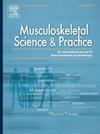What do we know about safety netting patients at risk of metastatic spinal cord compression? A scoping review
IF 2.2
3区 医学
Q1 REHABILITATION
引用次数: 0
Abstract
Background
Metastatic spinal cord compression is a potentially devastating consequence of cancer. This oncological emergency requires early recognition and treatment to prevent irreversible spinal cord injury and paralysis. Provision of information to at risk patients has been recommended in the 2023 NICE Guidelines. However, it is unclear when, how and what information should be provided.
Aim
To investigate how healthcare professionals provide safety netting information to patients at risk of metastatic spinal cord compression.
Methods
This scoping review utilised the Arksey and O'Malley Framework and the recommendations by the Joanna Briggs Institute. Relevant literature was identified following a systematic search of three databases, with grey literature accessed through a targeted search of relevant websites. Following data charting, thematic analysis was used to identify salient themes across the dataset.
Results
A total of N = 197 records were identified. Following removal of duplicates, title and abstract screening, N = 24 records were screened and N = 9 were included for full analysis. Three key themes were identified: information format and dissemination, health education and raising awareness, and timeliness of safety netting.
Implications
All patients with or at risk of developing bony metastases should be provided with safety netting information about metastatic spinal cord compression. Generalist clinicians should be prepared to share this information to empower patients to present early with symptoms. Further research is needed to explore the information needs and perspectives of patients with or at risk of metastatic spinal cord compression.
我们对有转移性脊髓压迫风险的患者的安全网了解多少?范围审查。
背景:转移性脊髓压迫是癌症的潜在破坏性后果。这种肿瘤急症需要及早发现和治疗,以防止不可逆转的脊髓损伤和瘫痪。2023年NICE指南建议向高危患者提供信息。然而,目前尚不清楚应在何时、如何以及提供何种信息。目的:调查医疗保健专业人员如何为有转移性脊髓压迫风险的患者提供安全网信息。方法:本综述采用了Arksey和O'Malley框架和乔安娜布里格斯研究所的建议。通过对三个数据库的系统搜索确定了相关文献,通过对相关网站的有针对性的搜索获得了灰色文献。在数据图表之后,使用主题分析来确定整个数据集的突出主题。结果:共识别N = 197条记录。在去除重复、标题和摘要筛选后,筛选了N = 24条记录,其中N = 9条纳入完整分析。确定了三个关键主题:信息格式和传播、卫生教育和提高认识以及安全网的及时性。意义:所有患有或有发生骨转移风险的患者都应提供有关转移性脊髓压迫的安全网信息。全科医生应该准备好分享这些信息,以使患者能够早期出现症状。需要进一步的研究来探索转移性脊髓压迫或有转移性脊髓压迫风险的患者的信息需求和观点。
本文章由计算机程序翻译,如有差异,请以英文原文为准。
求助全文
约1分钟内获得全文
求助全文
来源期刊

Musculoskeletal Science and Practice
Health Professions-Physical Therapy, Sports Therapy and Rehabilitation
CiteScore
4.10
自引率
8.70%
发文量
152
审稿时长
48 days
期刊介绍:
Musculoskeletal Science & Practice, international journal of musculoskeletal physiotherapy, is a peer-reviewed international journal (previously Manual Therapy), publishing high quality original research, review and Masterclass articles that contribute to improving the clinical understanding of appropriate care processes for musculoskeletal disorders. The journal publishes articles that influence or add to the body of evidence on diagnostic and therapeutic processes, patient centered care, guidelines for musculoskeletal therapeutics and theoretical models that support developments in assessment, diagnosis, clinical reasoning and interventions.
 求助内容:
求助内容: 应助结果提醒方式:
应助结果提醒方式:


